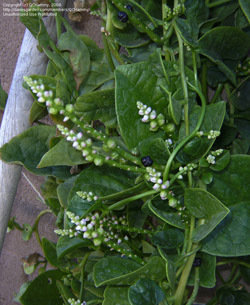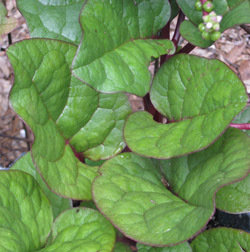





By late May or early June, most folks in the southern United States and other areas with hot summer temperatures have given up on growing lettuce, spinach, and other cool-season greens. There are some heat-resistant selections, but most of them are simply not happy when summer turns up the heat. Malabar spinach, however, thrives in the heat and humidity that even the hottest summer can dish out.
Malabar spinach (Basella alba) is native to India and Indonesia. Malabar, its namesake, applies to the southern part of India's western coast. Other names for this vine include Ceylon spinach, Indian spinach, vine spinach, and Malabar nightshade. Basella is a member of the Basellaceae family. It is not a part of the Chenopodiaceae family to which spinach (Spinacia oleracea) belongs.
Malabar spinach is a tender, fast-growing, tropical vine. Topping out at 10 to 12 feet tall, it is suitable for growing on relatively small supports such as large tomato cages or cages made of concrete reinforcing wire. Basella alba has heart-shaped leaves and white flowers, but the cultivar ‘Rubra' is more ornamental because of its thick, red to purple stems and leaf veins that contrast handsomely with the dark green leaves. Leaves are thick and succulent. Inconspicuous flowers that are white tinged with pink are borne on axillary spikes, and as the season progresses, they give way to fleshy, purplish black, single-seeded fruits.
 Growing Malabar Spinach
Growing Malabar Spinach
Malabar spinach grows well in full sun, although a bit of shade during the hottest part of the day, especially in the Deep South and tropical regions, protects it from midday wilting. Although it is tolerant of a wide pH range (4.3 to 7.0), it prefers soil that is well-drained and reasonably fertile.
Plants are easy from seeds or cuttings. Soaking the seeds in water overnight before sowing results in quick germination, usually within 7 or 8 days. Seeds can be planted outside where they are to grow, or they can be started indoors seven or eight weeks before the last frost date and then planted outside after a hardening-off treatment. Stems root easily, even after they are too tough to eat. Seeds can be saved from year to year. Simply dry the entire fruit and keep it until the following year. Both the solid green and the red-stemmed types come true from seeds.
Once you have Malabar spinach growing in the garden, a good crop of volunteer seedlings usually comes up the following year. The problem then becomes one of removing unwanted seedlings to prevent them from overtaking the tomatoes and peppers.
 Eating Malabar Spinach
Eating Malabar Spinach
Some users report that the raw leaves of Malabar spinach are delicious and have a hint of citrus and pepper. Usually it is cooked as a pot herb, and both the green- and red-stemmed varieties retain a fresh green color when cooked. It is reported to taste much like regular spinach. Because of the thickness of the succulent leaves, it doesn't wilt as quickly, so it holds its shape better in soups and stir-fries. A slight mucilaginous quality of the stems makes it useful as a thickener for soups and other dishes and is a good source of soluble fiber.
For those seeking organic vegetables, Malabar spinach is a shoe-in. Since it is easy to grow and amazingly free of any pests and diseases, even the most unseasoned gardener can experience success growing this plant. Nutritionally, it is a good bet because it is high in vitamins A and C, as well as iron, calcium, and chlorophyll. Try some of the leaves tossed with fresh quartered strawberries and a bit of thinly sliced onion. Dress this salad with a simple vinaigrette dressing made of a couple tablespoons each of olive oil and raspberry vinegar sweetened with a bit of sugar or artificial sweetener of your choice. Delicious!
As anyone knows who has handled the fruit, it contains an intensely red to purple dye that has been used for various purposes. It is a natural food colorant when used in dishes that do not require cooking. In certain cultures it has been used as rouge.
Even if you decide that the flavor of Malabar spinach is not for you, it is still worth growing. Grown on a trellis or other structure in the landscape, it is a thing of beauty. Several sources of Malabar spinach are listed on Dave's Garden PlantScout.
Thanks to QCHammy for the image of Basella alba.
Spinach Tree, Tread Softly, Cabbage Star, Chaya
Lambs-Quarters, White Goosefoot, Fat Hen, Wild Spinach
Ceylon Spinach, Climbing Spinach, Indian Spinach
How to Grow Spinach Even Your Kids Will Eat
Spinach: Planting, Growing and Harvesting Spinach Plants
10 Cold- and Heat-Tolerant Perennials and Shrubs for the Arid West
Container Gardening For Small Spaces
Tropical Hibiscus Flowers - How To Care For Them
Money Tree, Malabar Chestnut, Guyana (Guiana) Chestnut, Provision Tree, French Peanut
Summer Poinsettia, Josephs Coat, Tampala, Chinese Spinach, Vegetable Amaranth, Een Choy
Money Tree, Malabar Chestnut, Guyana (Guiana) Chestnut, Provision Tree, French Peanut
Copyright © www.100flowers.win Botanic Garden All Rights Reserved